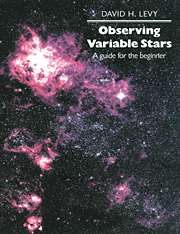Book contents
- Front Matter
- Contents
- Foreword
- Opening thoughts
- Acknowledgments
- Part 1 Getting to know the sky
- Part 2 Getting to know the variables
- Part 3 Suggested variables for observation throughout the year
- 24 Introduction
- 25 January, February, March
- 26 April, May, June
- 27 July, August, September
- 28 October, November, December
- 29 Southern sky notes
- Part 4 A miscellany
- Index
24 - Introduction
Published online by Cambridge University Press: 22 September 2009
- Front Matter
- Contents
- Foreword
- Opening thoughts
- Acknowledgments
- Part 1 Getting to know the sky
- Part 2 Getting to know the variables
- Part 3 Suggested variables for observation throughout the year
- 24 Introduction
- 25 January, February, March
- 26 April, May, June
- 27 July, August, September
- 28 October, November, December
- 29 Southern sky notes
- Part 4 A miscellany
- Index
Summary
This part of the book contains stars that have not been described in earlier chapters. It is intended to help you plan an observing program by introducing you to a selection of interesting variable stars. By reading through these chapters, you should find some stars that you will enjoy watching. The finder charts are intended to help in finding the location of a variable star. Once you have decided on a program, I suggest that you order a complete set of charts for each star you choose and be careful to plan in advance the best time and equipment for observing them. The order in which the different constellations are presented in each chapter represents a vague and somewhat arbitrary eastward movement across the sky.
For each star, I have included the range, period and a code that specifies level of difficulty:
1 = very easily found and estimated
2 = a good star for beginners
3 = some challenge, either in finding or in estimating
4 = quite difficult
5 = recommended only for advanced observers with larger instruments
Different sources provide different values for maxima, minima, and ranges of many variable stars, especially those with uncertain variations. In most cases I have used the values given in the General Catalogue of Variable Stars by B. V. Kukarkin et al., Fourth Edition.
- Type
- Chapter
- Information
- Observing Variable StarsA Guide for the Beginner, pp. 111Publisher: Cambridge University PressPrint publication year: 1989

